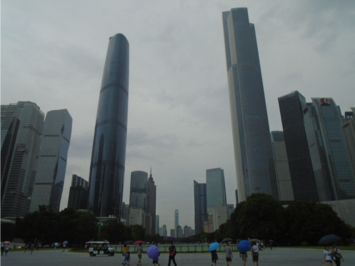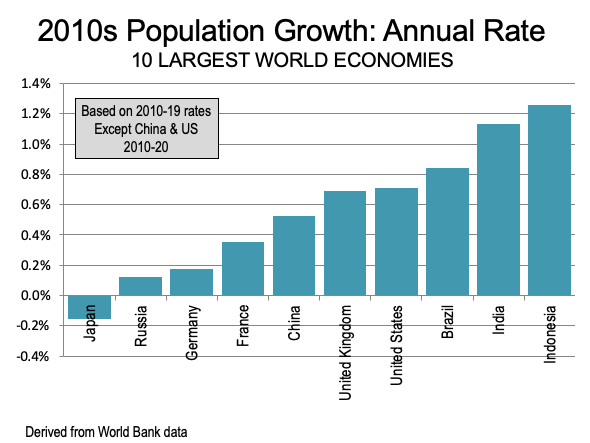
China added 70 million residents between 2010 and 2020, according to the seventh national population census, taken on November 1, 2020. This increase surprised some, such as the Financial Times, which had predicted a loss less than three weeks before the results were announced.
Regional Growth
There was considerable variation in the population changes across the country. This is indicated at the government designated regional level, made of up province equivalents, which are provinces, directly administered municipalities and autonomous regions (Table).
The Eastern region includes province equivalents on the Pacific Coast (east coast) from Hebei in the north to Guangdong in the south. Beijing, which reaches to within 80 kilometers (50 miles) of the coast is also included. The Eastern region captured 75% of the growth between the two censuses. With 563 million residents, the Eastern region also was the fastest growing, at 10.3%.
The Western region is the second largest, at 383 million and was the second fastest growing, at 6.1%. This was 31% of the national growth, and with the Eastern region represented more than 105% of the intercensal growth (21.6 million). The western region stretches from Guanxi, the southernmost Pacific Ocean province equivalent, west to Tibet and north to Shaanxiand Xinjiang.
The Central region is the third largest, at 365 million and grew 1.9% (6.7 million) and accounted for 10% of the total growth. The central region includes the province equivalents between the Eastern and Western regions.
The Northeastern region, also called Manchuria, suffered a loss of 11 million residents. Often referred to as China’s rust belt, the Northeast had a loss of 10.0%. It is to the north of the Eastern region and stretches all the way to the Russian border.
Province Equivalents
Guangdong, home of the most of the Pearl River (Zhujiang) Delta megalopolis (see Ultimate City: Guangdong-Hong Kong-Macao Greater Bay Area) is the largest jurisdiction, with a population of 126 million. Guangdong includes the two megacities of Guangzhou (see: The Evolving Urban Form: Guangzhou and Foshan) and Shenzhen (see: The Evolving Urban Form: Shenzhen). The province does not include the two special administrative regions of Hong Kong and Macao. Guangdong grew rapidly, with a 20.8% increase, second only to Tibet (which has only 3.6 million residents). Guangdong accounted for 31% of the total growth.
Zhejiang, with 65 million residents was the second largest and added the second most new residents, at 10.1 million. This is third strongest percentage growth, at 18.6%. Zhejiang is home to Hangzhou, where Marco Polo is reputed to have lived when it was the largest city in the world. It is adjacent to Shanghai and to the southwest. Zhejiang accounted for 15% of the total growth.
Jiangsu, home of Nanjing (see The Evolving Urban Form: Nanjing) and Suzhou (see: Edge Cities in China: Suzhou), added the third most residents, at 6.0 million. Jiangsu is adjacent to Shanghai, to the west. Jiangsu grew by 8% had 9% of the total growth. Jiangsu has much of the Shanghai area megalopolis, which stretches to Changzhou, almost two thirds of the way to Nanjing.
Guangdong and the two Shanghai area provinces (Zhejiang and Jiangsu) had 55% of the population growth.
The Xinjiang Autonomous Region was the fourth fastest growing proportionately, adding 18.5% and 4.0 million residents.
Other province equivalents growing more than 10% were Ningxia (17%) in the west, Fujian (13%) on the Pacific Coast between Shanghai and Guangdong, Beijing (11.6% and described below) and Chongqing (11.1%) in the Central region.
China’s two largest directly administered municipalities, Beijing and Shanghai grew, but at far lower rates than before. The larger, Shanghai added 1.9 million residents between 2010 and 2020, for growth of 8.0%. By contrast, between 2000 and 2010, Shanghai added 6.6 million residents, or 40% to its population (see: The Evolving Urban Form: Shanghai). In contrast, Beijing grew 2.3 million, or 11.6% between 2010 and 2020. This compares to a 6.0 million increase from 2000 to 2010, or 45%. Both municipalities undertook growth control measures and nearly all of their growth since 2010 was in the first half of the decade.
Shandong, which occupies the Shandong peninsula is the only other province equivalent with more than 100 million residents. It grew barely at all, adding only 1.5% to its population.
All three provinces in the Northeastern region (also called Dong-Bei, for “east-north” in Mandarin) had population losses. By far the largest was in Heilongjiang, at 17%, for a loss of 6.5 million. Jilin had a population loss of 12.3%, while Liaoning, closest to the prosperity of the Eastern region had the smallest loss, at 2.3% (See: Shanghai to Manchuria and Central China by Train).
Losses were also sustained in Shanxi (minus 5.7%), a resource rich province bordering Beijing to the west. Inner Mongolia, also resource rich and consisting of the entire western and northern border from Heilongjiang except for Xinjiang and a small part of Gansu in the far west, lost 2.7%. Gansu also lost 2.2%.
China Comparison to the United States
China’s 70 million increase was three times that of the United States as reported in the first results of the 2020 census (23 million). However, reflecting its larger population, China had a one-third smaller percentage gain (5.2%) that the US (7.7%). China has about 1.41 billion residents, about 4.5 times that of United States (0.33 billion).
The contrast between the US and China is particularly evident in comparing two functionally similar corridors in the two nations. The Shanghai to Beijing Corridor, served by the nation’s most intense high-speed rail service (serving the province equivalents of Shanghai, Jiangsu, Anhui, Shandong, Hebei, Tianjin, and Beijing), has a population of 383 million. In contrast the US “Acela” Corridor, named for Amtrak’s premier and most intensive rail service, operates from Washington to Boston (serving the Washington area, which includes Virginia, Washington, DC, and Maryland and also Delaware, Pennsylvania, New Jersey, New York, Connecticut, Rhode Island, and the Boston metropolitan area, which includes Massachusetts and New Hampshire). The area has a combined population of 70 million, barely a fifth of its Chinese equivalent.
The Shanghai to Beijing Corridor covers about 40% more land area than the Acela Corridor, but has a population density of 614 per square mile, nearly four times that of the Acela Corridor’s 157.
Despite China’s generally slower growth, Shanghai-Beijing, its most vital economic area, experienced growth of 4.6% over the past decade, more than double the 2.1% of the Acela Corridor.
China Population Growth in Context
China’s growth was in the middle among the 10 top economies of the world (Figure), growing more strongly than Germany or France but more slowly the US and the United Kingdom. China was the slowest growing among the four middle and upper middle income countries in the top 10 (which also includes Brazil, India and Indonesia). Following publication of the Census figures, China’s Politburo enacted a policy to allow families to have three children, rather than two, a policy that Hong Kong’s South China Morning Post said that the nation hopes will help tackle the problem of its ageing population. Just a few days ago, France 24 reported that consideration is being given to removing birth restrictions entirely.

View or download the China 2020 Census Table (PDF).
Wendell Cox is principal of Demographia, an international public policy firm located in the St. Louis metropolitan area. He is a founding senior fellow at the Urban Reform Institute, Houston, a Senior Fellow with the Frontier Centre for Public Policy in Winnipeg and a member of the Advisory Board of the Center for Demographics and Policy at Chapman University in Orange, California. He has served as a visiting professor at the Conservatoire National des Arts et Metiers in Paris. His principal interests are economics, poverty alleviation, demographics, urban policy and transport. He is co-author of the annual Demographia International Housing Affordability Survey and author of Demographia World Urban Areas.
Mayor Tom Bradley appointed him to three terms on the Los Angeles County Transportation Commission (1977-1985) and Speaker of the House Newt Gingrich appointed him to the Amtrak Reform Council, to complete the unexpired term of New Jersey Governor Christine Todd Whitman (1999-2002). He is author of War on the Dream: How Anti-Sprawl Policy Threatens the Quality of Life and Toward More Prosperous Cities: A Framing Essay on Urban Areas, Transport, Planning and the Dimensions of Sustainability.
Photo: Zhujiang New Town in Guangzhou, Capital of the Guangdong, the largest and second fastest growing province equivalent (by author).












